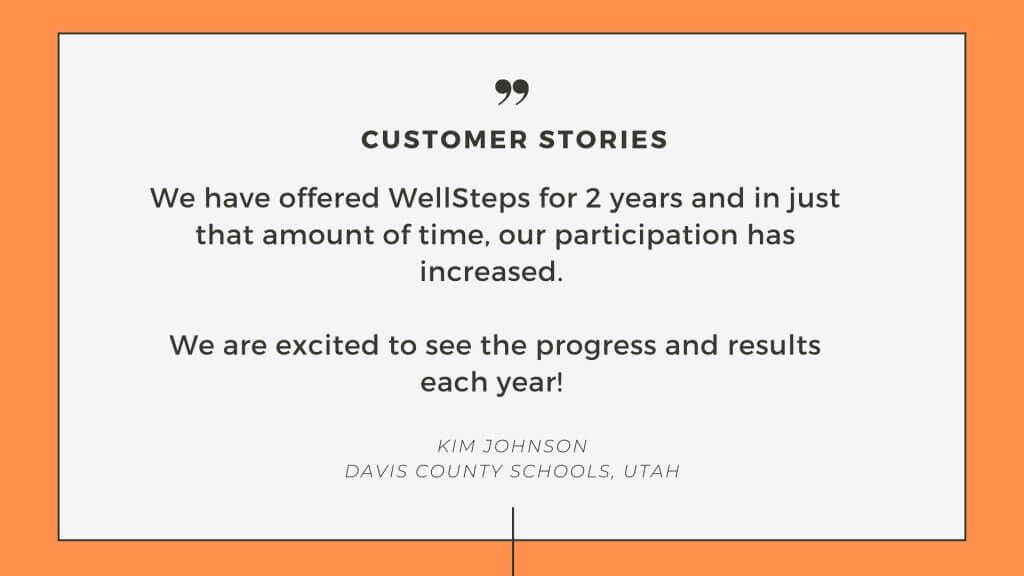It is becoming more and more apparent: small businesses need to look into an employee wellness program. There is overwhelming evidence that focusing on small business wellness makes a difference in both the employees’ lives and for the business.
What is a Small Business Wellness Program?
A small business wellness program is an initiative designed to foster better health within the workplace, specifically for companies with fewer employees. These programs often include:
- medical screenings
- incentives
- behavior change interventions
- fitness programs
- social support or competitions
It is common to see significant improvements when these programs first kick off, it is often more challenging to sustain these changes over extended periods of time, such as 12 months. For instance, an increase of half a vegetable serving per day doesn’t seem like much. However, it can have 4-5 times the impact compared to many community-based interventions.

RELATED: 7 Simple Strategies to Integrate Health and Wellness Programs in the Workplace
Impact of Wellness Programs on Small Businesses
A small company that WellSteps helped, Rural Wisconsin Health Cooperative, saw positive results with a wellness program for their 60 employees. They had 90% participation and saw significant improvements in health behavior and productivity.
Lincoln Industries, another small group, saw a 10 point drop in diastolic blood pressure and a 20 point drop in systolic blood pressure after three years among those employees with initially high blood pressure. Obesity rates also decreased or stayed relatively flat over a three year period — an impressive feat in and of itself.
While no wellness program is making obesity go away, you can work to keep it at a low level. These two companies illustrate the impact that a wellness program can have in small business settings. Having just one employee become healthier can make a big impact in a small company.
Having just one employee become healthier can make a big impact in a small company.
The majority of the companies in the United States are small businesses that employ fewer than ten people. In fact, half of all U.S. workers work in small businesses. Most of these workers have no access to a wellness program.
RELATED: Why Small Business Wellness is the Future

3 Barriers for Small Business Wellness Programs
Small employers need help implementing successful wellness programs. Repeatedly, it becomes evident that overlooking barriers can lead to ineffectiveness.
Here are some of the most common barriers small businesses encounter when striving to improve employee health and reduce employee-related expenses though wellness programs.
Return on Investment
First, wellness programs for small companies have a more difficult time quantifying a return on investment (ROI) solely through numerical data. Calculating ROI through reduced healthcare costs is more straightforward and accurate in larger corporations. As a result, the majority of ROI studies and case studies have been completed on large companies. f
All wellness ROI data from reduced medical spending comes from evaluations of large companies, not small businesses. This does not mean that small business wellness doesn’t reduce healthcare costs, it just means that there are no published scientific studies showing this.
The good news is that there are many other benefits to a small business wellness program besides lower healthcare costs.
RELATED: Employee Health Programs Worth Investing In
Health Insurance Costs
Second, small businesses are not self-insured. Small businesses share their health insurance costs with a pool of small employers. If the wellness program does improve employee health and lower healthcare costs, the savings are shared by the other employers in the pool.
Very little comes back to the employer in savings, since there are multiple fixed costs of administration, claims, commissions, profits, and risk and pool charges. It’s unrealistic for a wellness vendor to come in and say they can help with a major reduction in healthcare costs, since the employees’ health isn’t the only factor in determining healthcare costs.

It’s unrealistic for a wellness vendor to come in and say they can help with a major reduction in healthcare costs, since the employees’ health isn’t the only factor in determining healthcare costs.
With small businesses, you’ll see a blending of the company medical cost experience with other businesses. Even if a small business has the healthiest employees, any savings that occur will be shared by every business in the pool. A company could hope to reduce by only about 2-5% the cost of insurance premiums if they are a healthy group.
RELATED: The Costs and Advantages of an Employee Wellness Program
The Administrative Role
Perhaps the biggest barrier to small business wellness is the question of “who will oversee wellness initiatives?” In a small business, employees wear many different hats. Most likely the task of starting and administering a wellness program will be giving to an employee who already has multiple job roles and little, if any, experience running an effective wellness program.
It is rare for programs like this to actually succeed. A successful wellness program at a small business will require some outside help if it has any chance of showing positive outcomes.
RELATED: 5 Ways a Corporate Wellness Consultant Helps Programs
Advantages of Small Business Wellness
The advantages of doing wellness in a small business go way beyond a direct monetary ROI. There is strong social support to capitalize on and participation is always higher in a smaller group. In a small company where employee benefits may be limited, wellness can help build strong morale. Also, small business owners tend to care more about their employees — often creating an environment where everyone is treated like family.
The health benefits of small business wellness are also more important than the same benefits would be in a large corporation. In a small business setting absenteeism and presenteeism (physically at work but not really working) are more detrimental. Because there are so few employees, the absence of just one can make a big difference.
Unlike large companies there is not a group of employees who can pick up the slack or complete the unfinished work. Employee absence in small companies has a big impact. Employees who have health risks are more likely to be absent from work or to have reduced productivity.

Small businesses that do wellness see monetary savings outside the typical ROI healthcare cost measures. They may experience lower absenteeism, lower workers compensation fees, lower short and long-term disability and lower turnover. When employers send the message that they care about their employees’ health, they will see a return on their investment.
When employers send the message that they care about their employees’ health, they will see a return on their investment.
Research has shown that small business wellness programs can improve health behaviors and lower elevated health risk despite what odds may seem to be against them.
RELATED: 13 Office Wellness Ideas to Improve Employee Productivity
How Do I Start a Small Business Wellness Program?
Once an employer has addressed their barriers and understands the necessity of a worksite wellness program, what do they do next? Well, they have a few options.
Option 1: Go it Alone
The first — and arguably least effective — way is to go at it alone. This is where they pick, for example, the person in accounting who does yoga to be in charge.
It is unrealistic, however, to expect someone whose job description doesn’t involve wellness to create and manage a successful program.
Option 2: Use the Carriers Wellness Program
A company can also try and use insurance carrier programs. Most of these solutions offer nothing for small businesses. Anything they do offer is self-directed, meaning employees must take themselves to the website, log in and find what they want to do.
There is no evidence of effectiveness and, in fact, data from four of the largest carriers shows these programs reach less than 2-5% of employees. Self-directed programs have very poor participation. And, furthermore, they are only available if you stick with that carrier.
In other words, these programs are 100% self-serving for the carriers. If your company changes insurance carriers, all wellness efforts vanish. These programs range from free to $250 per person.

Option 3: Get Help From a Broker
A third option is to use an insurance broker to help with wellness. The brokerage might have an in-house wellness specialist that comes by and helps with a biometric screening and a health fair or a health risk appraisal. Unfortunately, these aren’t always available to small businesses, and there is no evidence that they work.
A big problem with health risk appraisals (HRAs) at small businesses is that aggregate data may not be available to view because the pool of employees may be too small to protect individual health information. This then eliminates one of the more effective tools in strategic program planning.
RELATED: 4 Ways Insurance Brokers Offer Wellness Programs to Employers
Option 4: Hire a Wellness Vendor
The final option is to hire a wellness vendor. A business that wants a successful wellness program needs someone who has direct ownership of the program and has the time to do what needs to be done.
A wellness vendor may be able to meet this need and may be able to do so at an affordable price. In a small company, there are limits to what kind of programming can be done.
A fitness facility onsite may not be an option, for example, and some programs can cost between $100-200 per person. This is where a broker is important. They can help find funding for wellness by adjusting co-pays, deductibles, premiums, or may even pay for the cost of the vendor’s wellness solution.
What Are Successful Small Businesses Doing?
The first thing a successful small business doing wellness has is leadership support; senior leader support is critical. If the CEO isn’t on board, the program won’t last very long.
Small business do the same things that larger companies do:
- health assessments
- culture audit and change processes
- activity and incentive tracking tools
- behavior change campaigns
- program evaluation
Other benefits offered in a wellness program:
- stress reduction programs
- recreational programs, such as company sponsored sports teams
- weight management programs
- smoking cessation programs
- one-on-one health coaching
- health screenings
- exercise programs and activities
- nutrition education
- vaccination clinics

At WellSteps, the WellSteps Guides work with coordinators at each location to handle much of the planning, administrative load, and implementation of wellness program components. Our WellSteps Guides are the secret behind every one of our successful small business wellness programs.
What Small Business Wellness Success Looks Like
Insurance brokers are typically small businesses. Borislow Insurance, a small brokerage company in the Northeast, has been exceptionally good at doing wellness. WellSteps has worked with them for many years and has published a case study on the impact of their wellness program.
Not only has Borislow Insurance benefited from having an employee wellness program, but they are now in a position to speak with authority about wellness.
As they talk about wellness with their various small business clients they gain trust because they have actually been practicing what they preach. It doesn’t make any sense for a brokerage firm to talk to their clients about wellness if they don’t do it themselves!
Next Steps For Your Small Business Wellness
Small businesses are the future of wellness. Because of specific barriers and advantages, small businesses need help conducting effective wellness programs.
If done correctly, small businesses can use wellness to improve employee health and the bottom line. Discover how in a Free Demo with our team and we’ll show you the best next steps you can take.
